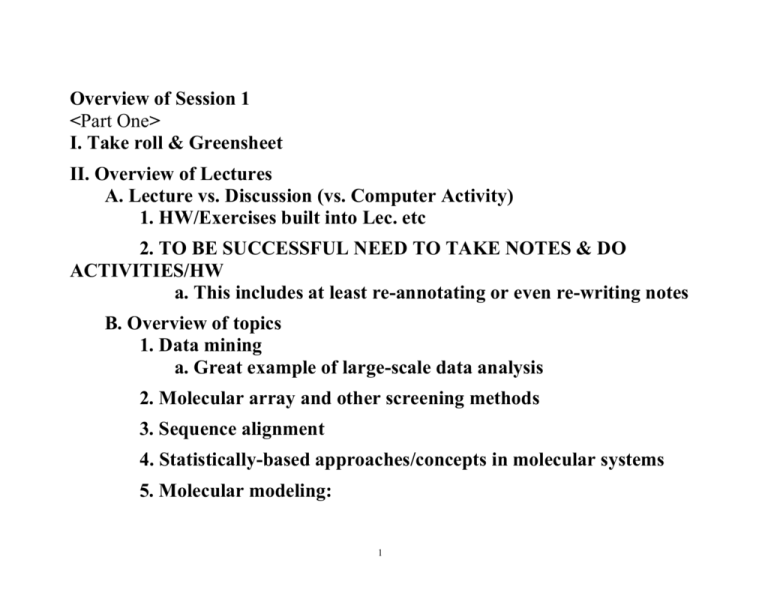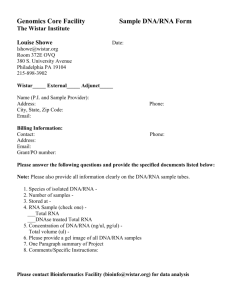Suppl. Lec1 (session 1)
advertisement

Overview of Session 1
<Part One>
I. Take roll & Greensheet
II. Overview of Lectures
A. Lecture vs. Discussion (vs. Computer Activity)
1. HW/Exercises built into Lec. etc
2. TO BE SUCCESSFUL NEED TO TAKE NOTES & DO
ACTIVITIES/HW
a. This includes at least re-annotating or even re-writing notes
B. Overview of topics
1. Data mining
a. Great example of large-scale data analysis
2. Molecular array and other screening methods
3. Sequence alignment
4..Statistically-based approaches/concepts in molecular systems
5. Molecular modeling:
1
a. Common file structures: GenBank and PDB
b. RNA as a model system
c. Molecular mechanics, threading and integration of sequence
homology
6. All-atom modeling for biological systems
III. Midterm
A. Covers preceding lecs., in-class and HW activities
1. Limited open-book
B. Will largely include questions describing and analyzing broad
themes in Bioinformatics e.g. role of sequence conservation in Genomics or
Proteomics
C. In-class exam (bring 2 blue books, unless other arrangements
indicated week before midterm)
IV. Practical issues for class-project
2
A. Projects will be suggested by instructors and are in context of specific
experiments or by observations of other data e.g. genomic or structural
B. Initially can use small-scale (e.g. simple spreadsheets) w/ smallest
possible data set(s)) and/or standard online or outside server specialized
software
C. Work in groups of 3 if at all possible
1. Brainstorming with your group really is effective
2. Division of labor according to expertise (one Biol/Biochem and one
ChE/MatE and another Engr of any category; w/ at least one computationally
‘sophisticated’ individual)
V. Grant Proposal
A. Grant Proposal (each person in group writes their own, but share
preliminary results data/analysis, but not text): General form (in order and
with corresponding headings; with page numbers except for Title Page as well
as not required for Figures and Tables; at least 15 pages of text double-spaced
which excludes ref. listings)
3
1. Layout
a. Title Page
b. Abstract
c. Introduction (at least six pages)
i. Significance
ii. Specific Aims (< 1 page and essentially motivate Proposed
Tasks)
d. Methods (includes Prel. and/or Expected Results)
i. Can include your text from Prelim. Results Assignment
(about 7 pages of text), includes one paragraph specifically describing your
role
e. Proposed Tasks (each one a paragraph and include specifics of
any experiments and allotted time and at least one paragraph of Justification)
f. References (at least 15 research articles and at least 2 review
articles)
4
g. Figure Legends (if applicable and note all can be embedded in
above text)
h. Figures and Tables (if applicable and note otherwise all can be
embedded in above text if Figure Legends are also)
2. Note CME Guidelines for citing and listing of references, pp9-14 of
http://www.engr.sjsu.edu/cme/Student_Resources/Advising/CMEThesisGuidelines.pdf
3. Electronic version due on May 19 (at 1715 in-class i.e. ENG
407)/Hard-copy due by 4:00 PM on May 22 in DH417 (and if Instructor not
there, then give to Chem Office Staff in DH518 <a “dropbox” will be
provided>)
VI. Grant Proposal Presentations (more details in later presentation)
A. Format -- PowerPoint (a laptop and LCD projector will be available)
1. Duration: ~40 minutes.
a. Exact duration of presentation will be determined by the
number of students (and groups) enrolled in the course.
2. Demos: If you plan (or would like) to give a live demo during your
presentation, please speak with the instructor(s) first to discuss logistics and to
5
make sure presentations stay within the allotted time.
3. Individual Participation: Each group member must present an
amount of time that equals ~ (allotted time) / (no. group members).
4. Audience & Style of Presentations Audience: Presentations should
target an imagined audience that does not have the technical background and
sophistication of the presenters. Imagine presenting to high-level senior
managers and VP type individuals.
5. Style: Presentations must incorporate a significant amount of the
concepts, practices, and techniques of preparing and making presentations
that are covered in the course.
B. Grading
1. Will be based, in part, on the grant project
2. Degree to which presentations stay within the allotted time limit for
the group and individuals
3. How well targets the "imagined" audience, and incorporate the
6
above style requirements
E. Presentation skills
VII. Add/Drop and related issues
IX. Break
7
<Part Two: Review>
I. Some basic biology
A. Central Dogma
Transcription
Translation
DNA--------------->RNA---------->Proteins
Replication
B. DNA (deoxyribonucleic acid)
1. Portions that code for a specific protein are referred to as a gene
a. Typically, coding regions can be more generally referred to as
exons
b. Noncoding regions include introns
2. Consists of a polymer (i.e. string) of basic building blocks called
nucleotides
http://search.eb.com/eb/art-2658
http://www.vivo.colostate.edu/hbooks/genetics/biotech/basics/nastruct.html
8
3. Replication involves one new daughter strand replicating from the
template for each of the two original parent strands (original duplex)
4. In more complex organisms that are described as being diploid, this
also describes two “non-exact” copies of each duplex per cell
C. RNA (ribonucleic acid)
1. Typically describes a single "string" (i.e. strand or chain) of
nucleotides similar but not identical to DNA
a. Differences include a base component uracil of the nucleotide
labeled as U instead of the base component thymine of the DNA nucleotide
labeled T
i. In addition the sugar component of the RNA nucleotides
labeled as A, C, G and U have an additional functional OH group
http://www.tulane.edu/~biochem/nolan/lectures/rna/frames/nucs.htm
note from previous sanctioned link
ii. This explains the usage of label, DNA (i.e.
deoxyribonucleic acid)
9
b. Transcription involves single strand of RNA being synthesized
(i.e. put together) "from" one template DNA strand
i. RNA nucleotide is matched w/ the DNA nucleotide; for ex.
G goes w/ C and vice versa (and U goes w/ A <but not vice versa>)
2. Several types of RNA
a. Messenger RNA (mRNA)
b. Primarily “structural” (still essential to build physical
framework of Translation machinery)
i. Transfer RNA (tRNA)
ii. Ribosomal RNA (rRNA)
c. Micro RNA (miRNA) and other short RNAs have proposed
regulatory function
D. Proteins
1. Remember the code from the DNA gene is "transcribed" into a
messenger RNA; that messenger RNA (i.e. mRNA) is then "translated" into a
protein
10
2. Proteins are made up of one or more chains of amino acids (some 20
amino acids) linked together
a. http://www.elmhurst.edu/~chm/vchembook/565proteins.html
link from sanctioned site (if site busy check wikipedia
http://en.wikipedia.org/wiki/Peptide_bond)
b. “N-terminal portion” of a cyt c
3. Chain(s) of amino acids fold on themselves and the resulting very
specific structure has very specific function
i. One notable example are enzymes which are biological catalysts
(i.e. molecules that speed-up specific chemical reactions)
11
ii. Other ones are primarily cellular communication or
“structural” in nature
iii. Contrast i vs. ii
A
S----> P
but instead
Z
|
X ----A ----Y
4. Now comes the second statement of "Dogma":
Sequence=Structure=Function
II. Current Research Landscape of
A. Key Areas
1. Genomics
a. Sequencing (i.e. identifying the order of A,C,G or T) in the
DNA of various organisms
b. Identifying the function of particular sequences (especially
those corresponding to genes)
12
2. Proteomics
a. Identify and isolate proteins in-vivo
i. Now there is "protein on a chip" and similarly other affinity
methods
b. Various 2D methods, such as 2D gels
http://www.nature.com/nature/journal/v402/n6758/full/402147a0.html
download pdf (Houry et al., 1999 and check figs. 3 and 4):
<http://www.nature.com/nature/journal/v402/n6758/pdf/402147a0.pdf>
or Mass Spec coupled w/ another method <such as HPLC>
c. Determine function (includes possible interactions w/ other
proteins)
3. Other experimental screening of binding species (i.e. ligands) and
other biological species/agents
a. Key aspect of drug development
4. Gathering and further analyzing info. experimental From A
and B (this aspect often referred to as (though not exclusively
Bioinformatics) i.e “Bioinformatics: The merger of biotechnology and
13
information technology with the goal of revealing new insights and
principles in biology.”
a. This require huge amounts of computational resources,
including extensive databases
b. Allows us to begin modeling various levels of
organization/function in biology
i. Functional interactions e.g. protein/peptides-nucleic acid
interactions (can be part of designing peptides as drugs)
ii. Organelles e.g. ribosome
iii. Cell
(a) Prokaryotes (simple single cell organisms w/ no
nucleus and e.g. E. coli is key model organism)
(b) Eukaryotes
(1) Have nucleus, which includes a membrane
enclosing it
(2) And is what all multi-cellular organisms involve
14
(3) Exons are typically associated
(c) One current goal of Synthetic Biology is creating an
“artificial” simple organism
http://www.sciencemag.org/cgi/content/abstract/319/5867/1215
(Gibson et al., 2008)
III. Review on Statistics
A. Characteristics of a distribution
1. Mean (average), Median, Mode
2. Gaussian (i.e. Normal) distribution often assumed
3. Overview of least-squares fit to straight line
a. Minimize chi**2
b. Get slope, intercept and correlation coefficient
i. Corr. coeff. insufficient for statistical validity
ii. Need to evaluate corr. coeff. for a given set of points w/
respect to a random sample of data points <DF is degrees of freedom, assume
is two for now>
(a) See link http://www.graphpad.com/quickcalcs/PValue1.cfm
15
(b) Shotgun analogy- <for a set of 100 shotgun blasts,
each w/ exactly 10 pellets etc>
B. Linear Regression Assignment: Do tutorial up to (but not including)
‘Linear regression w/ built-in functions’
http://phoenix.phys.clemson.edu/tutorials/excel/regression.html
{What is P value for tutorial data set? Is it statistically significant, explain?}
1. See any of the three editions of Bevington, P.R. Data Reduction and
Error Analysis for The Physical Sciences, McGraw-Hill, NY for derivation of
“Linear Regression Equations” and anything else about practical statistics
(note 2nd edition is in King Reserves 1st Flr). QA278.B48 1992
IV. Assignment starting at end of class
A. Read selected sections from menu options of NCBI (National Center for
Biotechnology Information) site; be able to contextualize today’s Review)
1. Go To Molecular Genetics, 1ST one:
http://www.ncbi.nlm.nih.gov/About/primer/genetics.html
a. Required to do “What is a Cell” thru “Fig. 3’
16
2. Required to do “Whats in a Genome” up to (but not including)
‘Mechanisms of Genetic Variation and Heredity’
3. Alternatively how to get to them: In Left-hand Menu About
NCBI A Science Primer {…. }
B. Need hard-copy of hard to find, essential “sub-site”:
http://www.ncbi.nlm.nih.gov/Education/BLASTinfo/glossary2.html
17
18




